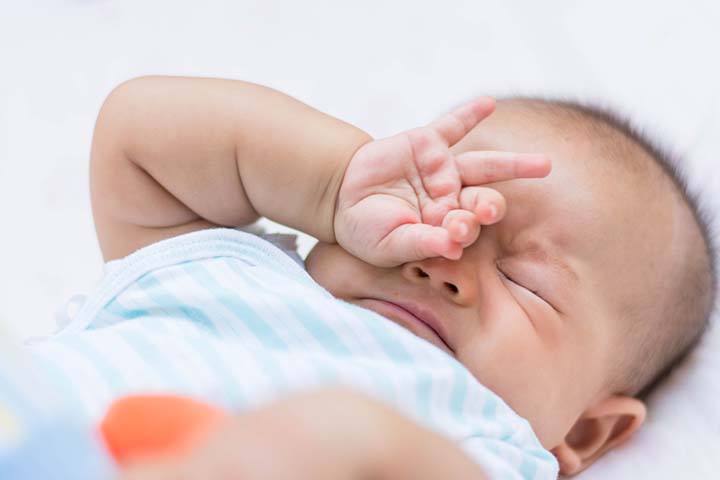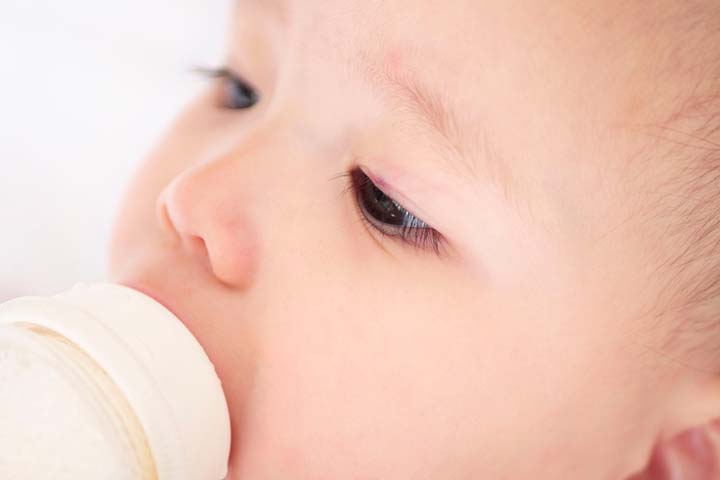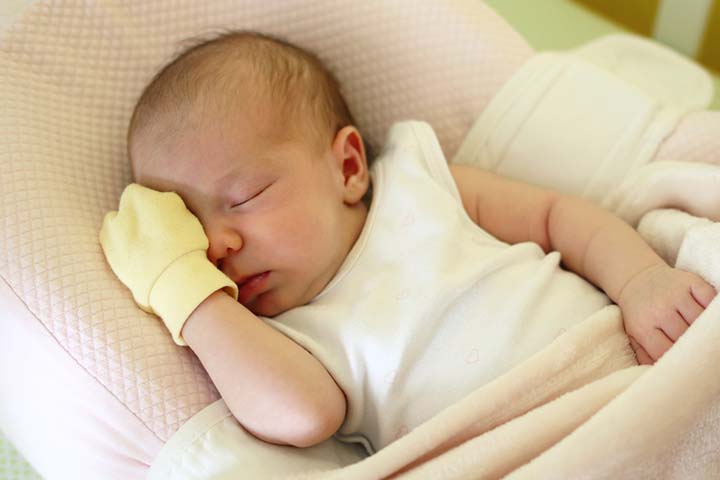Babies have delicate eyes that may get irritated easily (1) Irritated eyes may present as redness around the baby’s eyes or itching in the eyes. For most children, the redness subsides by itself without any medical intervention. However, it is important to contact your child’s pediatrician if you notice any other signs of eye irritation, such as watery eyes or sticky discharge.
Read this post to learn more about the causes, home remedies, and treatment for redness around the baby’s eyes.
Cause Of Redness Around Baby’s Eyes
Redness under the eyes in infants could be due to an irritant, infection, or tear duct blockage. A blocked tear duct or irritant should resolve by itself with minor remedies. If the cause is an infection, causing discharge and pain, you should visit a pediatrician.
Dr. Yuna Rapoport, MD, MPH, a US-based board-certified and fellowship-trained ophthalmologist, says, “Redness around the eyes in a baby is usually mild, like contact dermatitis. It may go away on its own or sometimes need an over-the-counter steroid ointment or a lubricating ointment.
“Occasionally, redness around the eyes in a baby may be an infectious condition such as preseptal cellulitis or orbital cellulitis, which have to be treated with antibiotics. In rare cases, redness around the eyes may mean a rare malignant tumor such as retinoblastoma. If the redness presents suddenly and is only in one eye, this rare entity should be ruled out.”
Since babies have extremely sensitive skin and eyes, they are prone to react to any substance instantly. Some possible reasons causing redness around your baby’s eyes are as follows:
- Rubbing: If your baby or toddler has a habit of rubbing their eyes frequently, this might be the cause of the redness around their eyes. It is usually not a reason for concern and can probably resolve by itself.
- Allergies: Histamine is usually released from the baby’s eyes when they contact an allergen (2). Due to this, there might be visible redness and swelling surrounding the eyes. It might also lead to watery discharge from the eyes.
- Eye Infections: Exposure to bacteria or viruses can cause infections in a baby’s eyes.
-
- Viral conjunctivitisiXInfection or inflammation of the transparent membrane that covers eyelids and eyeball: The most common viruses causing conjunctivitis in babies are AdenovirusiXA virus that can infect the eyes, gastrointestinal tract, and respiratory tract and Herpes virus. It causes redness in and around the eyes and is known as pink eye (3).
- Bacterial conjunctivitis: Bacterial conjunctivitis is commonly caused by Haemophilus influenzae or Streptococcus pneumoniae. The symptoms include periorbital cellulitisiXThe space between the skin of the eyelid and the bony region that surrounds the eye and redness around the pupil. In some cases, white or yellow discharge is seen.
- Newborn conjunctivitis: This type of conjunctivitis occurs when the baby is exposed to certain harmful viruses or bacteria in the birth canal during delivery. According to the Centers For Disease Control And Prevention (CDC), it may be caused due to irritation or a blocked tear duct and leads to eye discharge (4)
- Impetigo contagiosa: It is another bacterial infection caused by Staphylococcus aureus or Streptococcus pyogenes that occurs rarely in babies over two months of age. These bacteria cause blisters that burst, forming reddish crusts on the face (around the nose and mouth), soft tissue regions, and the extremities. As a contagious infection, this may spread to the baby from another infected person, such as the mother or other children around the infant. Impetigo contagiosa may also turn into an eye infection by causing crusts on the baby’s eyelids, especially if the baby touches their eyes with the same hand, cloth, or other objects that have touched their infected skin (5) (6) (7).
.
- Sty: A sty is a painful lump near the edge of the eyelid and is often filled with pus (8). It looks like a boil or pimple and develops due to the blockage of the small drainage glands lining the eyelids.
- Periorbital cellulitis: Periorbital cellulitis is a skin infection affecting the eyelids. It can be caused due to an insect or animal bite or due to conjunctivitis. If the infection reaches the inner areas of the eyelids, it is known as orbital cellulitis (9) and might lead to serious repercussions.
- Cleaning and hygiene products: Babies have soft and sensitive skin that can react to the slightest exposure to harmful or harsh chemicals (1). If the shampoo, soap, or any other product contains such substances, it can cause reactions, such as redness and irritation around the circumferential area of the eyes.
- Dry/dehydrated skin: Another possible reason for redness around the eye area may be due to the skin being dehydrated and lacking in moisture.
A pediatric ophthalmologist or pediatrician can help determine the root cause of the redness around a baby’s eyes and provide suitable treatment options after conducting a thorough physical evaluation and reviewing the medical history.
Home Remedies For Red Rash Around Baby’s Eyes
If you notice redness around your baby’s eyes, you can start home treatment after consulting with the baby’s pediatrician.
- If you notice your baby rubbing their eyes frequently, consider covering their hands with mittens to help prevent scratches and reduce the frequency of rubbing.
- Change your baby’s soap to a mild and gentle one that has no harsh chemicals.
- Apply moisturizers to help prevent dryness of the skin (1).
- If the redness around the eyes is accompanied by pain and swelling, applying a warm compress (a soft cloth dipped in warm water) can help soothe the pain.
- Avoid the use of substances that might act as allergens for your baby.
Besides these, the American Academy of Pediatrics (AAP) recommends avoiding direct contact with your child’s eyes or the eye discharge until redness in and around the eyes is clear (10).
Treatment For Redness Around Baby’s Eyes
If the redness encircling the eyes persists, it is advisable to consult your doctor at the earliest. Some of the probable treatment measures are as follows (11)(12) (13):
- Taking care of your child’s eyes through proper ocular hygiene is the first and vital step in relieving redness.
- Artificial tears can help prevent dry eyes.
- Ibuprofen and other over-the-counter pain relief options can provide helpful relief.
- Oral antibioticsiXA medicine used to treat bacterial infections in humans and animals help treat conjunctivitis
- Antibiotic eye drops or ointments can relieve swelling, pain and also reduce redness in case of a bacterial infection or viral conjunctivitis
- Simple probe surgery if there is a blocked tear duct
- Antibiotics through IV; however, this is rare in cases of cellulitis
Redness around a baby’s eye may be concerning for any parent. Redness may occur due to something as simple as rubbing or scratching to something more serious. Your doctor may help you diagnose the underlying cause, if any. Do not try home remedies without consulting your doctor because the eyes are a vital organ. The redness mostly subsides by itself in a few days. If you notice accompanying signs such as fever or swelling that does not reduce or worsen, you should consult a pediatrician to rule out other infections.
Key Pointers
- Vigorous eye rubbing, allergies, conjunctivitis, sty, etc., are some reasons children may have redness around their eyes.
- Warm compresses, moisturizers, and mild soaps help manage redness around a baby’s eyes.
- Your doctor might prescribe antibiotics, probe surgeries, etc., based on the underlying cause to treat redness around the eyes.














